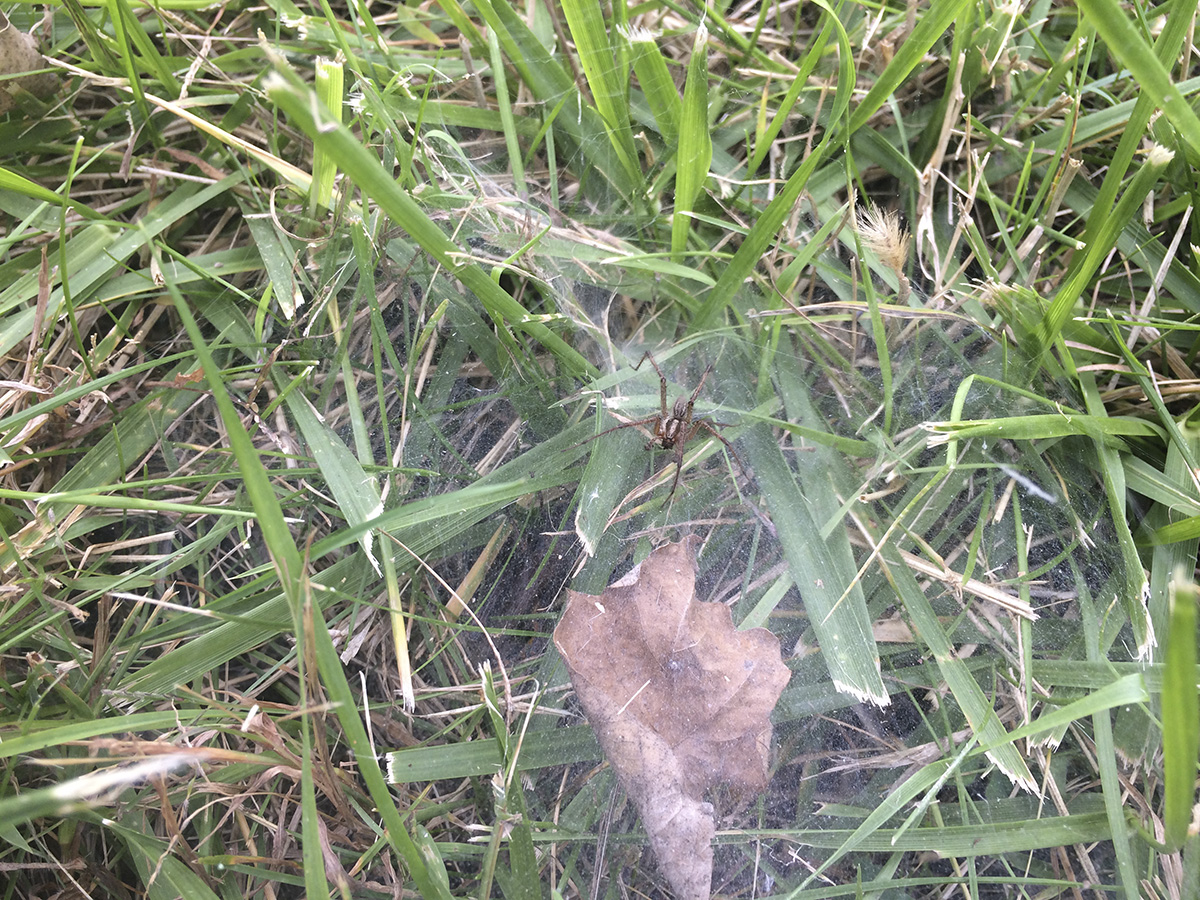
By Jody Green, PhD, Extension Educator
This article focuses on three spiders often seen this time of year. The spiders mentioned in this article are not aggressive or harmful to humans and pets. On occasion, spiders may be found indoors, but generally, they remain outdoors where prey is plentiful. Spiders are nocturnal predators that readily consume flies, crickets, ants, silverfish, moths and beetles. Because of their ability to remove a great number of pests, they are considered beneficial in the landscape.
ORB WEAVER SPIDER
Orb weavers (family: Araneidae) are named so because of their web-spinning behavior. They spin the classic, vertically flat, circular web that people commonly associate with spiders. Orb weavers may vary in size and shape. Their sizes range from 1/4-inch to over 1-inch long (total body length, not including the legs). They are known for having a large ball-shaped abdomen, small eyes and hanging out in the center of the orb web. They are slow-moving, passive hunters that wait for flying insects to get caught in their sticky webs.
Webs may be anchored to a building, tree branches, tall grass or other types of vegetation. Some orb weavers consume their web each morning and then build a new one at night. Orb weavers get noticed during late summer and fall when they are at their largest size. Female orb weavers generally remain in a particular spot with the goal of leaving an egg sac filled with hundreds of eggs before dying at first frost.
GRASS SPIDER/FUNNEL WEAVER
Grass spiders (family: Agelenidae) are also known as funnel weavers because the web they construct is a horizontal sheet with a small funnel-like tube off to the side or center. They are brown spiders with two thick, dark, longitudinal stripes through the cephalothorax and tapered abdomens with long, prominent spinnerets. Grass spiders can be 1/2–3/4-inch long. They are not considered large, but they are very quick.
The funnel is a protected place to hide. When an insect falls or lands on the non-sticky sheet web, the spider rushes out to take it back into the funnel. The webs, which become visible when covered in dew or debris, are constructed in bushes, grass, flowerbeds and wood piles around windows, light fixtures and corners around the house. A large number of grass spiders can live in a small area, but each web has only one female.
WOLF SPIDER
Wolf spiders (family: Lycosidae) are the largest spiders in Nebraska with their total body size ranging between 1/4-inch to 1-1/4-inches long. Rabid wolf spiders resemble grass spiders due to their smaller size, but others such as Carolina or tiger wolf spiders are large-bodied, robust spiders, with striped and spiny legs. All wolf spiders are solitary, active hunters with superb camouflage and excellent vision. Their eight eyes, which glow at night when a light shines on them, are arranged so they can see all around them.
Wolf spiders hunt on the ground and do build webs, though some may hide in burrows. They can be found under stones, landscape timbers, firewood, leaves and other debris. Although large and sometimes frightening, female wolf spiders are known to provide exceptional parental care since they can be observed carrying round, egg sacs on their spinnerets and then after the spiderlings hatch, carrying them on the top of their abdomens for several weeks.
CONTROL METHODS
Management for spiders consist of minimizing food, eliminating shelter and harborage and excluding them from entering into buildings.
• Minimize prey by turning off exterior lights at night, reducing leaf litter, sanitation of landscaping, cleaning gutters and downspouts.
• Practice exclusion techniques by sealing cracks, and installing weather stripping under doors and around windows.
• Inspect items like plants, firewood and moving boxes brought into the home.
• Vacuum or sweep windows, corners of rooms, storage areas, basement and garages.
• Reduce harborage areas by reducing clutter, using air-tight storage containers, and keep boxes off the floor and away from wall.
• Remove unsightly webs from around the building and ornamental plants.
• Insecticides are not the most effective way to keep spiders out, as spiders can avoid residues if not sprayed directly. Sticky glue boards are a non-toxic way to remove spiders with proper placement (indoors adjacent to walls, close to possible entry points).
• Remove individual spiders using a jar and piece of thick paper.
SPIDER BITES ARE RARE; FOR DEFENSE
Spiders are not poisonous; they are venomous*. The purpose of spider venom is for the spider to subdue and feed on prey, which are usually insects and other small invertebrates. Though the thought or sight of a spider is enough to elicit fear and anxiety, spider bites are rare and occur when a spider is accidentally pressed against a person’s body and/or defending itself from harm.
*The term venomous is applied to organisms that bite or sting to inject toxins (i.e. snakes, bees and wasps), whereas the term poisonous applies to the negative affect the toxins have when an organism is eaten, licked or touched (i.e. poison ivy or poison dart frogs).